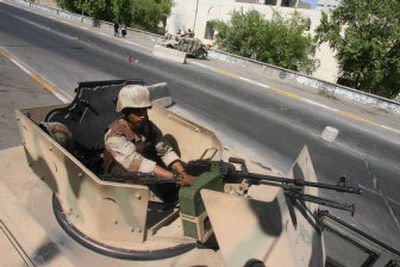Officials plan security ring around Baghdad

BAGHDAD, Iraq – U.S. military and Iraqi security forces have begun a massive effort to seal off Baghdad with a ring of reinforced checkpoints, berms, trenches, barriers and fences, in an attempt to clamp down on insurgents, officials said Friday.
A few dozen checkpoints will be placed along key arteries in and out of Baghdad to ensure that people move through “predictable paths” that can be controlled, Lt. Col. Barry Johnson, a U.S. military spokesman, said late Friday night. Iraqi forces will man the checkpoints and patrol the terrain, with support from U.S. troops.
“We know there’s a flow in and out of the city of those who are responsible for the violence,” Johnson said. “The intent is to control Baghdad city.”
The plans were announced on a day when 52 bound and tortured corpses were found across Baghdad over the past 24 hours, officials said. Baghdad’s body count has surged in recent days, despite a month-old push by thousands of U.S. and Iraqi forces to tame some of the capital’s roughest neighborhoods.
The construction of a ring around Baghdad would be the most ambitious security endeavor yet for the U.S. military and its Iraqi allies as they try to block militias, death squads and insurgents from funneling in weapons, explosives, funding, and recruits from outside the capital.
“The enemy is changing tactics, and we’re adapting,” President Bush said Friday in Washington. “The enemy moves, and we will help the Iraqis move. And so they’re building a berm around the city to make it harder for people to come in with explosive devices, for example. … They got a clear-build-and-hold strategy.”
The project arrives as sectarian violence is emerging as the biggest challenge to U.S. and Iraqi forces engaged in what some U.S. officials have called the Battle for Baghdad, a confrontation that could strongly influence the future path of Iraq.
“We’re trying to knock down sectarian violence and go after those folks, those death squads that have caused this new form of violence, that if left unchecked could lead to civil war,” said Lt. Gen. Peter Chiarelli, the second-ranking U.S. military officer in Iraq.
The effort to wrap Baghdad in a protective bubble is not a new tactic. In Fallujah, U.S. and Iraqi forces have controlled the entry and exit into the city since an assault by U.S. forces in November 2004. The U.S. military has erected berms around the volatile town of Samarra, where the February bombing of a Shiite shrine triggered the sectarian violence now ravaging Baghdad. The dirt ridges, a few feet high, largely serve to channel traffic.
Johnson, the military spokesman, said the Baghdad project has been under way for a few weeks and that building has begun. The plan is to use the natural terrain where possible and reinforce existing barriers, “complementing them with trenches, in other places berms, and other types of fencing.”
Such efforts are among the methods that counterinsurgency experts recommend to gain control over population movements. Yet some analysts also say that the United States has never taken what many of them contend is an essential first step in population control: conducting a thorough census and then issuing identity cards and requiring all people to carry them at all times.
It is unclear whether the complex of berms, trenches and checkpoints project will be effective in Baghdad, a megalopolis of 81 square miles that includes vast stretches of farmland and open terrain. Insurgents and members of private militias may still be able to avoid the checkpoints; even if they don’t, U.S. and Iraqi forces will still face the problem of identifying them.